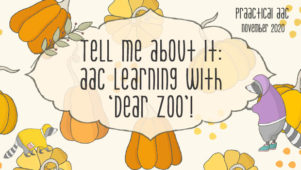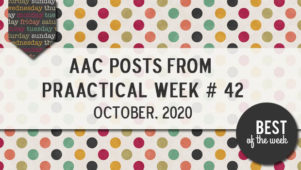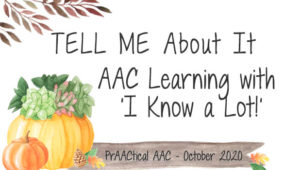TELL ME About It: AAC Learning with ‘The Lunch Box Surprise’!
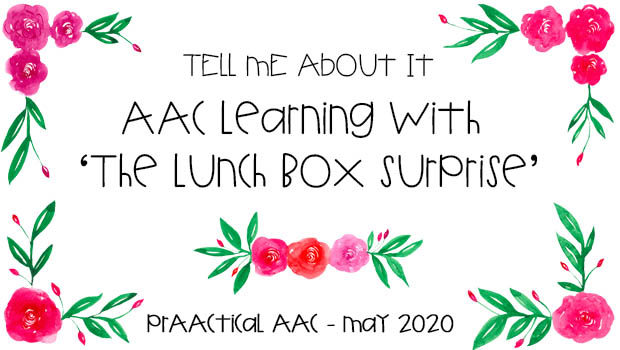
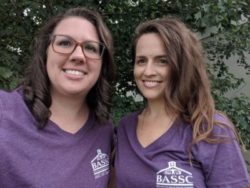 Reading with preschoolers is a great way to build language and AAC skills. Today, we share another post in the TELL ME About It series on incorporating AAC, language, and literacy support with young learnes.. Maggie Judson and Jeanna Antrim are back with more great ideas for AAC intervention, this time focusing on the book, Come Out and Play, Little Mouse.
Reading with preschoolers is a great way to build language and AAC skills. Today, we share another post in the TELL ME About It series on incorporating AAC, language, and literacy support with young learnes.. Maggie Judson and Jeanna Antrim are back with more great ideas for AAC intervention, this time focusing on the book, Come Out and Play, Little Mouse.
Maggie and Jeanna are speech-language pathologists who work in the Assistive Technology Department for the Belleville Area Special Services Cooperative (BASSC) in central Illinois. They are AT/AAC facilitators and provide evaluations, direct therapy, consultations, and trainings.
To read more about how this team prepares for a TELL ME week, check out their previous posts in the TELL ME About It series.
- Come Out and Play, Little Mouse
- No, David
- Go Away Big Green Monster
- What Do You Like?
- Here Are My Hands
- From Head to Toe
- I Went Walking
- Brown Bear, Brown Bear
- TELL ME AAC Literacy Kits
Don’t miss their videos modeling book reading with two AAC systems toward the end of this post.
TELL ME About It: AAC Learning with ‘The Lunch Box Surprise’!
TELL ME About Reading
The ninth book in the TELL ME program (Teaching Early Language and Literacy through Multimodal Expression) is “The Lunch Box Surprise.” Such a motivating, engaging book since it revolves around a very fun topic – food! And usually, every child has an opinion when it comes to food, which creates a natural opportunity for commenting and initiating with the use of core words! Check out below for the book focus of “The Lunch Box Surprise”:
Book Focus: The Lunch Box Surprise
- Core Words (BOW WOW Words): BOY, GIRL, HAPPY, SAD, EAT
- Additional Words (Tiger Talk Words): friend, give, ready
- Concept Vocabulary: food and feelings
- Special Letter: c
- Book Concept: Letter vs. Word
TELL ME About Writing
Today’s writing activities are described below:
- Before Writing: Review the core words BOY, EAT, GIRL, HAPPY, and SAD by verbally saying them and locating them on the students’ AAC systems. Once you have reviewed the words, write the title of the chart, and explain that everyone will write more tomorrow using those core words.
- Writing: After the students have participated in writing the predictable chart, the real fun begins – you create a mini book from the chart the class created! Pass out the mini-books to each student and tell them, “You wrote a book. Here it is! I like your book!”. Then, everyone reads through the book together, pointing to each word in the sentences as they do. After you have read through the book, the students can then go on a word hunt for their target words: BOY, GIRL, HAPPY, SAD, EAT, FRIEND, GIVE, and READY.
- After Writing: To wrap up the writing lesson, have everyone join in on singing the letter song for the letter ‘c’ and do the letter activity. Today’s letter activity is the Letter Bucket. This activity is very similar to ‘What’s in the bag?’ and just as big of a hit! Get a bucket and fill it with various objects that start with the letter ‘c.’ As you or the students reach in and bring out an object, discuss how it begins with the letter ‘c.’ For example, if the student pulls out a caterpillar, you could say, “BOYS and GIRLS. Look, a caterpillar! Caterpillar starts with the letter ‘c.’”
TELL ME More
Below are some specific ideas on how to implement “The Lunch Box Surprise” in your therapy sessions and classrooms TELL ME-style!
- Activity – Snack time!
Snack time is often used as an opportunity to teach students to request because of that strong motivating food factor. But don’t let the magic of snack time stop there! This is also a perfect opportunity to role model, teach, and elicit conversational skills. Hang up the ‘who’ and ‘what’ QUICK QUACK QUESTION poster near the snack table, so that you can review it during snack time. 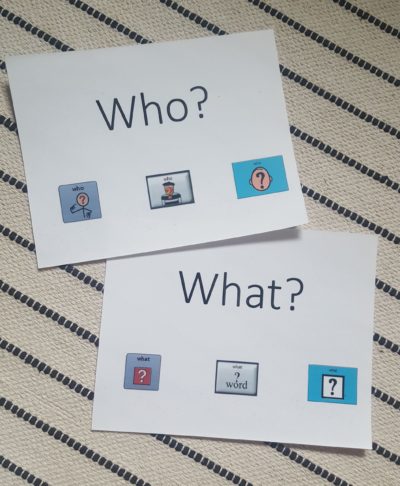 Questions you could ask and model are:
Questions you could ask and model are:
- Who is that GIRL?
- What is that BOY EATing?
- Popcorn makes me HAPPY!
- I feel SAD when snack time is over.
- Teaching Strategy – Behavioral support!
At times, to help students transition into or sustain attention during a shared reading activity, there may be a need to provide visual supports. A few of our go-to’s are lanyard visual supports and a reading choice board:
- Lanyard: One of the first communication supports that we provide to the teams we work with is a ‘cored-out’ lanyard. These lanyards have behavioral support core words, mini manual communication boards, and a mini first-then board set up with core vocabulary. With this little transportable powerhouse, we always have communication supports on the ready, no matter the setting or situation! These also come in handy for reading anywhere and anytime, since they’re always with us and always available!
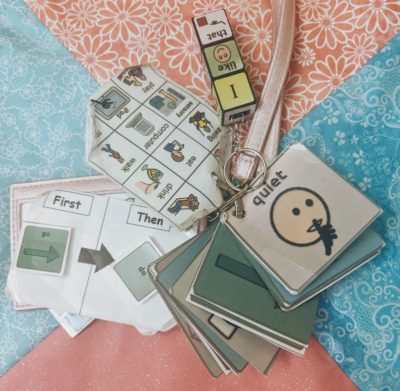
- “First read, then we EAT our snack.”
- “GIVE me the Fancy Nancy book, please.”
- Reading Choice Board: One fun way to spice up those oh so important re-readings is to provide a reading choice board. It’s a great way to give students a sense of control and to build excitement for their shared reading session. Because really, what’s more fun for a student than telling an adult how to do something?! They can ask you to read the book like a monster, or a robot, or a squeaky mouse! We love this choice board that AACreATively created and posted about on social media (you can find her on Facebook and Instagram). It provides the students with the ability to have a say in the book reading, and it instantly ups the fun factor by having the book read in a fun, silly voice!
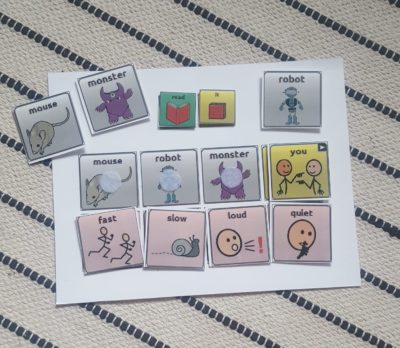
- “Are you READY to read?”
- “Read it like a BOY monster.”
- “Read it like a HAPPY robot!”
- Implementation Tip – Recipe fun!
As we mentioned before, food is typically a positive motivator for many of our students. And what could be a better FUNctional AACtivity to incorporate into the weekly routine than cooking! A cooking activity, whether making jello, trail mix, or pizza, can provide for so much learning! It offers multiple opportunities for literacy learning and for eliciting a variety of communicative functions.
- Literacy opportunities may include (but are definitely not limited to!): reading the recipe, identifying the target letter in the name of the food or ingredients, and writing about the cooking activity.
- “The last step says we can EAT it!”
- “Look, I see the special letter ‘c’ in the recipe!”
- “Are we READY to write about what we made to EAT?”
- Communicative functions that could be modeled or elicited during a cooking activity may include: making requests, protesting, commenting, asking questions, answering questions, showing/describing, and joking.
- “Look! I made a HAPPY pizza!”
- ‘The onions in the salad made me SAD.”
- “Are the cookies READY?”
- “BOY, I sure love to EAT!”
- “You put the spoon down, are you READY to GIVE your FRIEND a turn to cook?”
And remember! You do not need to come up with the recipe and lesson plan all on your own. TELL ME provides a cooking activity for each book in the program. Yay! Thank you, TELL ME!
- Aided Language Input Tip – Commenting!
Commenting about personal preference is an important communication skill, and really gets to the heart of the reason why we communicate – to share our thoughts and opinions! And while our students tend to have ever-changing interests, likes, and dislikes, they may need direct instruction on how to express these thoughts. Incorporating aided language input for commenting during book reading provides a platform to work on this skill on the daily! And one great way to visually demonstrate the communicative function of commenting is through the use of rating scales. Some different types of rating scales you can use include:
- A numeric scale (e.g., 1…2…3…4…5)
- A star scale
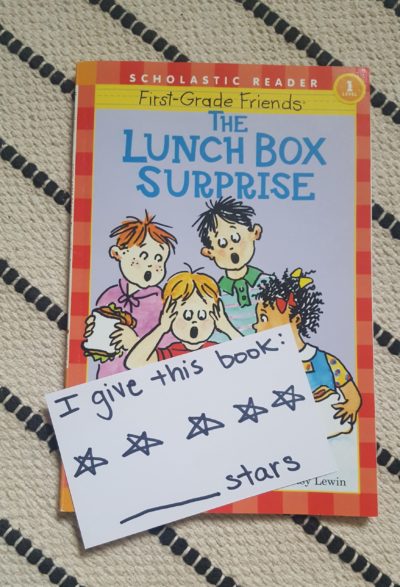
- A smiley face scale

- A word/feeling scale
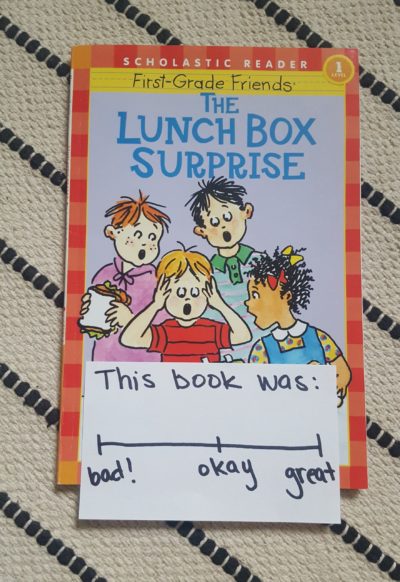
- Goal Ideas – Providing shared reading and writing opportunities directly relates to IEP goals, as these activities align with various core standards. Here are some examples you may find applicable:
- ELA-Literacy.W.K.3:Use a combination of drawing, dictating, and writing to narrate a single event or several loosely linked events, tell about the events in the order in which they occurred, and provide a reaction to what happened.
- ELA-Literacy.W.K.7: Participate in shared research and writing projects (e.g., explore a number of books by a favorite author and express opinions about them).
———————————————————————————————————————
RESOURCES and REFERENCES
- You can purchase the TELL ME manual from the Attainment Company or from ASHA.
- You can learn more about the program by watching the webinar TELL ME: AAC for the Preschool Classroom presented by Dr. Carole Zangari, available from Saltillo (bit.ly/2RNpykn).
You can find our Lesson Planning form for “The Lunch Box Surprise” and a blank form here.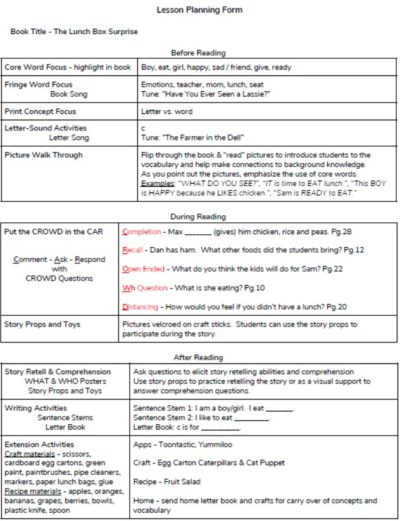
Check out the videos of us reading the book “The Lunch Box Surprise” while providing aided language input.
The Lunch Box Surprise with Snap Core First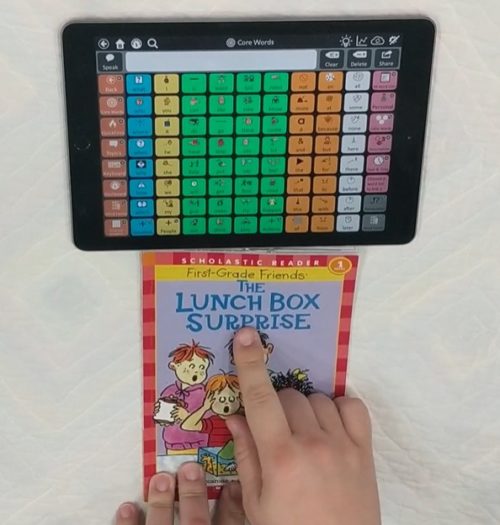
Direct Link to Video: https://www.youtube.com/watch?v=nsNMvV1tHso&feature=youtu.be
The Lunch Box Surprise with WordPower 60 Basic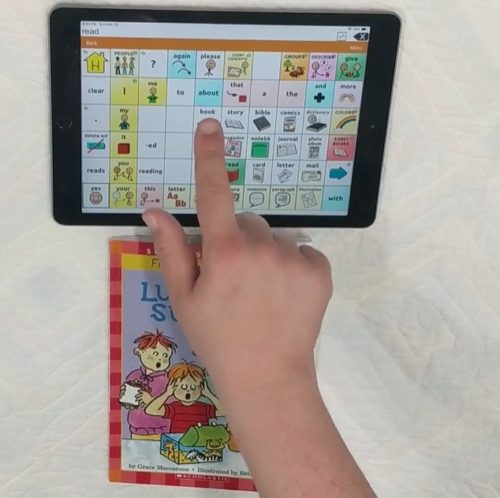
Direct Link to Video: https://www.youtube.com/watch?v=o-N8q8E-8dA&feature=youtu.be
The Lunch Box Surprise with LAMP Words for Life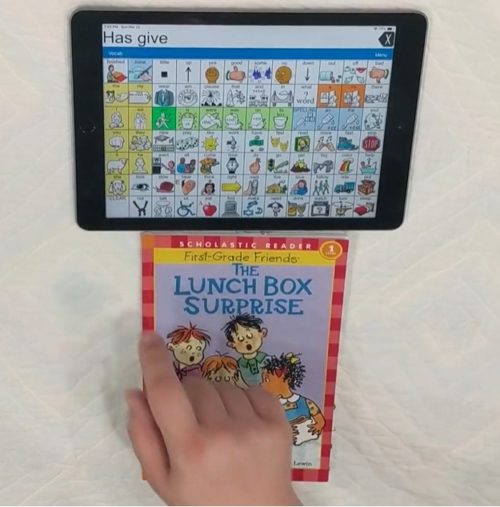
Direct Link to Video – https://www.youtube.com/watch?v=iLOq80qAfxQ&feature=youtu.be
Be sure to check back next month as we work through the TELL ME manual and share activities, teaching strategies and implementation tips for the next book in the program, “If You’re Angry and You Know It”!
Follow us on Instagram @basscAAC and subscribe to our YouTube channel (basscAAC) for more AAC implementation ideas!
Filed under: Featured Posts, PrAACtical Thinking
Tagged With: literacy, TELL ME
This post was written by Carole Zangari


